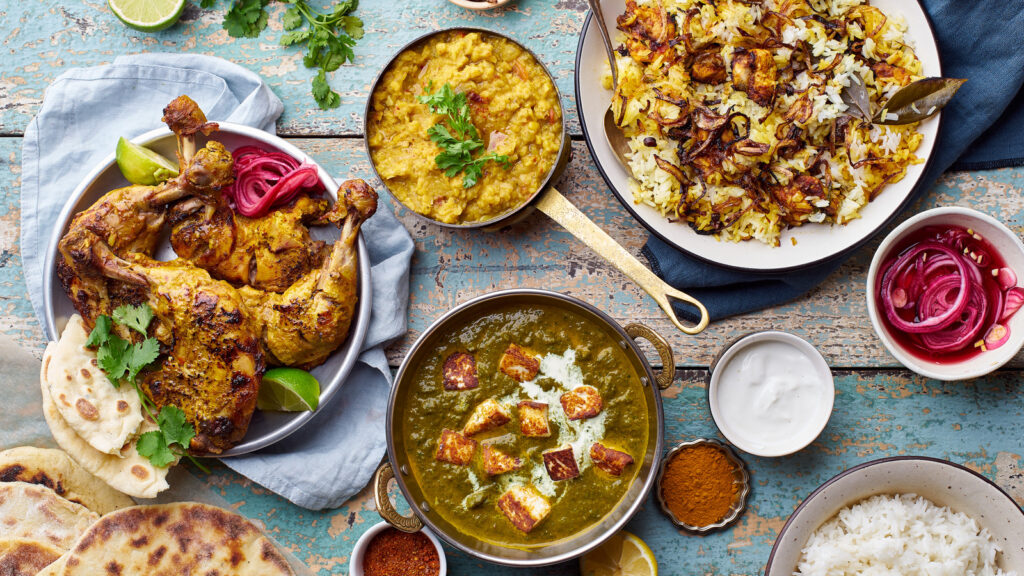Pakistan, a land of diverse cultures and rich history, offers a culinary landscape that is as varied and vibrant as its people. Pakistani cuisine is a delicious blend of regional flavors, influenced by the country’s Mughal, Persian, Afghan, and Central Asian heritage. This comprehensive guide will take you on a culinary journey through the most famous foods of Pakistan, showcasing the flavors that define this South Asian nation.
1. Biryani
Origin and History:
- Mughal Influence: Biryani, a fragrant rice dish, has its roots in the Mughal Empire. It combines aromatic basmati rice with meat (chicken, mutton, or beef), yogurt, and a blend of spices.
- Regional Variations: Pakistani biryani varies by region, with notable versions including Karachi Biryani, Sindhi Biryani, and Lahore Biryani.
Ingredients and Preparation:
- Main Ingredients: Basmati rice, meat (chicken, mutton, beef), yogurt, onions, tomatoes, garlic, ginger, green chilies, and a blend of spices (cardamom, cinnamon, cloves, bay leaves, and saffron).
- Cooking Method: The meat is marinated with yogurt and spices, then layered with partially cooked rice and slow-cooked in a sealed pot (dum) to allow the flavors to meld together.
2. Nihari
Origin and History:
- Mughal Influence: Nihari is a slow-cooked stew, traditionally eaten as a breakfast dish. It originated in the Mughal kitchens and is particularly popular in Lahore and Karachi.
- Cultural Significance: It is often prepared during special occasions and religious festivals.
Ingredients and Preparation:
- Main Ingredients: Beef or mutton shanks, bone marrow, ginger, garlic, onions, yogurt, and a special blend of spices (including nihari masala).
- Cooking Method: The meat is slow-cooked overnight with spices and bone marrow, resulting in a rich, flavorful stew. It is typically garnished with fresh ginger, green chilies, and cilantro, and served with naan or paratha.
3. Haleem
Origin and History:
- Arab Influence: Haleem is a thick, hearty stew made from a mixture of meat, lentils, and wheat. It has roots in Arab cuisine and was introduced to the Indian subcontinent during the Mughal period.
- Cultural Significance: It is especially popular during Ramadan and Muharram.
Ingredients and Preparation:
- Main Ingredients: Beef or mutton, lentils (split chickpeas, red lentils, and black gram), wheat, barley, ginger, garlic, and a blend of spices.
- Cooking Method: The meat, lentils, and grains are slow-cooked for several hours until they reach a porridge-like consistency. The dish is garnished with fried onions, cilantro, green chilies, lemon, and ginger.
4. Karahi
Origin and History:
- Local Specialty: Karahi is a popular Pakistani dish named after the wok-like cooking vessel it is prepared in. It is known for its rich and spicy flavor.
- Regional Variations: Chicken Karahi and Mutton Karahi are the most common versions, with variations in spice levels and ingredients based on regional preferences.
Ingredients and Preparation:
- Main Ingredients: Chicken or mutton, tomatoes, green chilies, ginger, garlic, yogurt, and a blend of spices.
- Cooking Method: The meat is cooked with tomatoes, green chilies, and spices in a karahi until tender. The dish is often garnished with fresh ginger and cilantro and served with naan or roti.
5. Chapli Kebab
Origin and History:
- Pashtun Cuisine: Chapli Kebab is a specialty of Pashtun cuisine, originating from the Khyber Pakhtunkhwa province. It is a popular street food and party dish.
- Cultural Significance: These kebabs are often served during festive occasions and family gatherings.
Ingredients and Preparation:
- Main Ingredients: Ground beef or mutton, onions, tomatoes, green chilies, ginger, garlic, eggs, and a blend of spices (including coriander seeds, cumin, and garam masala).
- Cooking Method: The ground meat is mixed with spices, vegetables, and eggs, then shaped into flat patties and shallow-fried until crispy.
6. Saag
Origin and History:
- Punjabi Specialty: Saag is a traditional Punjabi dish made from leafy greens such as spinach, mustard greens, and fenugreek. It is a winter staple in the Punjab region.
- Cultural Significance: It is often served with makki di roti (cornmeal flatbread) and enjoyed during family meals.
Ingredients and Preparation:
- Main Ingredients: Spinach, mustard greens, fenugreek, garlic, ginger, green chilies, and cornmeal.
- Cooking Method: The greens are cooked with spices and cornmeal until they reach a thick, creamy consistency. The dish is typically garnished with butter or ghee.
7. Seekh Kebab
Origin and History:
- Mughal Influence: Seekh Kebabs have their origins in the Mughal Empire and are a popular barbecue dish in Pakistan.
- Cultural Significance: They are often served at weddings, parties, and during the Eid festivities.
Ingredients and Preparation:
- Main Ingredients: Ground beef or mutton, onions, garlic, ginger, green chilies, and a blend of spices (including cumin, coriander, and garam masala).
- Cooking Method: The ground meat is mixed with spices and herbs, then shaped onto skewers and grilled until cooked through.
8. Golgappa (Pani Puri)
Origin and History:
- Street Food Delight: Golgappa, known as Pani Puri in other parts of the Indian subcontinent, is a popular street food in Pakistan.
- Cultural Significance: It is a beloved snack, especially enjoyed during the hot summer months.
Ingredients and Preparation:
- Main Ingredients: Hollow puri shells, spicy tamarind water, chickpeas, potatoes, and chaat masala.
- Cooking Method: The puri shells are filled with a mixture of chickpeas and potatoes, then dipped in spicy tamarind water before being eaten in one bite.
Conclusion: Celebrating Pakistani Cuisine
The rich culinary heritage of Pakistan offers a delightful array of flavors and dishes that reflect the country’s diverse culture and history. From the aromatic biryani to the spicy karahi and the hearty haleem, Pakistani cuisine has something to offer for every palate.
Key Takeaways:
- Explore the regional variations and historical influences behind Pakistan’s most famous foods.
- Discover the unique ingredients and cooking methods that define each dish.
- Appreciate the cultural significance of these dishes, enjoyed during festivals, family gatherings, and everyday meals.
By delving into the famous foods of Pakistan, you not only savor the rich flavors but also gain a deeper understanding of the country’s cultural and culinary traditions.












